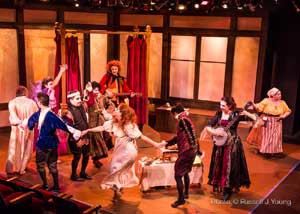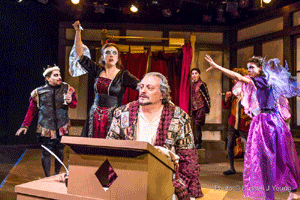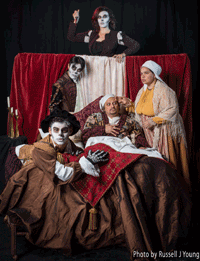ABOUT THE PLAY
Shakespeare is alive but not well at all. His time draws near and friends from “the other side” have begun to visit! But are these friends real or simply the creations of his imagination? Hamlet, Ophelia, Titania and more circle his deathbed while he fights to write his last play! Has he gone mad? Is he reading too many stories of the New World? What surprises will the joy of Día de los Muertos bring to the beloved Bard?
REVIEWS & COMMENTS
Shakespeare’s altar ego
Milagro’s multilingual historical fiction meets the Bard on his Day of the Deathbed
NOVEMBER 4, 2014 // Artslandia + ArtsWatch// A.L. ADAMS
What do you put on a Dia de los Muertos altar? Candles, claro. Flowers, por supuesto. But there’s a place, too, for more surprising stuff. Like a Pez dispenser, say, or a shoe. Anything goes, assuming it means something significant about the dead person being honored, to the living person who put it there. And once it’s placed, it stays. More pieces may be added, but typically, nothing is taken away.

The same principle is at play in Milagro Theatre‘s O Romeo, a much-if-n0t-all-encompassing bilingual homage to Shakespeare that runs through Sunday. It arranges a loving clutter of his plays’ characters around the figure of a dying Bard to perform a pageant of remembrance and reimagination. As O Romeo‘s Shakespeare (Anthony Green) takes to his deathbed, he’s visited by specters from his writings.
Ophelia (Rebecca Ridenour), in a white nightie, hands out herbs and flowers to baffled onlookers. Titania (Tara Hershberger) flits around playing a flute. A composite jester dubbed “Yorick” (Jake Wiest) jokes and tumbles in the irreverent fashion Shakespeare’s fools favor. Lady Macbeth (Danielle Chaves) and Richard III (Enrique E. Andrade) preen haughtily and sing opera while they collude on a sinister scheme to destroy Shakespeare’s writings and exonerate their blighted names. Polonius (Arlena Barnes) pontificates, Hamlet (Heath Hyun-Houghton) broods … and we’re made to understand that one more young joven that Shakespeare deems “Romeo” is actually—in a twist the Bard can’t emotionally process—his nonfictional son Hamnet (Otniel Henig), who died young.
Click here to learn more
Meanwhile, in Milagro’s adjacent Zócalo Community Space, visitors can browse a collection of themed altars designed by local artists from Latino collective FusionArte. A community memorial altar is filled with photos of the recently passed—some installed with the piece, some added since by visitors. A children’s altar, called Holy Innocents, is adorned with toys and a little bank where, as a token, one could leave a coin. And then there’s Shakespeare’s altar, where a skeleton decked out in Elizabethan garb reclines amid red roses on a rollable gurney.
“Even though he’s dead, we just keep rolling him out,” quipped Milagro artist, host and docent Vincente Guzman-Orozco to a patron, an apt comment for a show that essentially reanimates the Bard to play with him. The show, like an altar, is a monument of remembrance, full of an array of representations that are open to interpretation. It differs from a historical retelling in the same way that the items on a day-of-the-dead altar differ from the artifacts in a museum exhibit.
O Romeo‘s biggest fictional flourishes are giving him a Jewish/Spanish house servant named Rifke (Sofia May-Cuxim), and imagining that his final masterpiece-in-progress was a play set in “the new world” that’s since become Mexico. Shakespeare’s spectral characters perform a condensed version of this pretend play, complete with Aztec feather headdresses, within the second act. Aesthetically, it’s exciting. Historically, of course, it’s fast and loose.
This practice of casting real-life historical figures as themselves in a fictitious narrative has obvious pros and cons. It risks rewriting or distorting public perception of history, yet it endeavors to enliven history’s great personalities in a way that renews contemporary audiences’ otherwise flagging interest. The theory is, if you enjoy a historical figure’s persona as interpreted in an entertaining fictional context, you may be able to transfer that enjoyment to the (otherwise dry) process of learning that figure’s actual history.
How often it pans out that way is impossible to say. For instance, how many teens-at-heart who enjoyed Freud and Socrates in Bill & Ted’s Excellent Adventure went on to research their philosophies, versus how many simply giggled and picked up the boys’ bad habit of pronouncing Socrates “So crates?” And how many viewers of the Oscar-winning 1998 film Shakespeare in Loveunderstood it as fiction, versus leaving the theater half-believing that Shakespeare had an affair with Gwyneth Paltrow? For my part, when I read Barbara Kingsolver’s The Lacuna—similar to O Romeo in that it describes famous historical figures Frida Kahlo and Diego Rivera through the eyes of their fictitious house servant—I did feel its intended effect: History brought to life. Humanity brought to legends. I might even go back and read the referenced history. Or at least, that’s what I tell myself.
Portland Shakespeare Project The Complete Works Project’s plea to all local theater companies to put on Bard-centric shows caught Milagro at a convenient moment, as the theater sought a theme for its longstanding annual Dia de los Muertos pageant. A pairing of the two ideas seemed natural to devisor/director Olga Sanchez, and she spent about seven weeks developing it with the cast. ThoughO Romeo, as a newly devised piece, doesn’t help Complete Works meet its quota of plays penned by Shakespeare, it’s definitely (ahem) “in the spirit” of the effort.
Speaking of spirits … though apparently unintentional, O Romeo‘s parallels to Dickens’ Christmas Carol are nearly impossible to ignore. An elderly man, hardened by life’s losses, has a long lucid dream in his bedchamber, where he’s visited by a succession of spirits who ply him to new understandings. This trebles the show’s seasonal relevance to cover the current Shakespeare push, the just-ended Day of the Dead, and the upcoming Christmas.
Like many of Milagro’s shows over the years, O Romeo gives Spanish-speaking and bilingual audiences more for their money than only-English speakers. (In the past couple of years, Milagro has begun projecting translations during some, but not all, shows. This one doesn’t have ‘em.) Rifke’s asides and jokes often earn a laugh in her native tongue without being repeated in English. According to the largely bilingual cast, modern Spanish speakers actually have an advantage over their English-only contemporaries when it comes to appreciating translations of Shakespeare. “Spanish has remained more consistent since Shakespeare’s time, while English has changed more,” explained actor Sofia May-Cuxim during a talkback. “So what we hear in translations of Shakespeare, is closer to what we’re still saying in Spanish.”
But—also signature Milagro—the show is dreamy and impressionistic enough that it doesn’t require complete comprehension for general enjoyment. Its best moments are musical, mysterious, or both. The ensemble sings beautifully and plays Amir Shirazi’s arrangements and originals adeptly, and dual leads Green and May-Cuxim conjure poignant emotion—spine-tingling and near tears—at key moments in the story. Language may be left-brained, but this pageantry and sentiment feels right.
Mary Bothwell, 10/27/14
What a wonderful afternoon! I introduced my friend Colleen to Teatro Milagro, and even though she knows no Spanish and not much about Shakespeare, it didn’t make any difference. Vicente showed us around the ofrendas, and he is great! I bet the school kids love him. After all the rain I was ready for a good belly laugh! I have been telling everyone all day about the play. What fun!
Lauren Potter, 10/27/14
A powerfully comedic, deeply human work of metatheatre that challenges its audience to examine the roles we play on the grand stage of life and the undying possibility to rewrite stories and renew spirits. Beautifully written and inspirationally performed. Bravo!

‘O Romeo!,’ a Latino look at Shakespeare, a sparkling hit at Milagro Theatre
By Holly Johnson | Special to The Oregonian on October 25, 2014
Shakespeare sits in his room writing — and coughing. Though he suspects he is dying, he works on.
His final effort is a love story about an Aztec maiden and a Spanish priest, who link the New World and the Old. He’s heard about the Day of the Dead from his servant Rifke, and learns that if you build an altar in the dead’s honor, they will come, those spirits. Who he doesn’t expect to arrive are his characters, along with the spirit of his dead son, Hamnet, descending on him with unleashed vigor.
“O Romeo!,” currently at Milagro Theatre, is a fireball of a play — tender, irreverent, emotional and playful, one of the company’s best.
Click here to learn more
Ronni Lacroute, 10/23/14
What a remarkable evening of devised and multicultural theatre tonight at Milagro Theatre with a very clever, original, and entertaining Shakespeare-inspired ¡ORomeo! directed and created by Olga Sanchez! This piece of theatre is appealing on many levels with its references to the works of Shakespeare, its colorful characters, beautiful design elements, fabulous singing and dancing, jokes and parody, fight scenes and love scenes, Mexican culture, gorgeous costumes both Shakespearean and Aztec, instrumental music both familiar and original. The whole cast was terrific, and I especially enjoyed the diversity of ethnicities, shapes, voices, experience levels–such great casting! I think that everyone will find something to enjoy in this show, from frequent theatre-goers who will understand the insider Shakespeare jokes to first-time attendees who will like the action-packed story with humor, song and dance
¡O Romeo!
SHANNON GORMLEY, Willamette Week, October 22, 2014
If nothing else, ¡O Romeo! is incredibly charming. Every year, Miracle Theatre finds a different way to celebrate the Day of the Dead, and this original, bilingual production finds Shakespeare on his deathbed, with his characters brought to life and trying to persuade the playwright not to destroy his life’s work. Director Olga Sanchez is most interested in having some campy fun: Even Anthony Green, as the supposedly sickly Bard, performs emphatically. Most of the characters are from Hamlet, even though Polonius and the Danish prince himself make only brief appearances, which feels like a missed comedic opportunity. Jake Wiest’s Yorick and Sofia May-Cuxim’s Rifke—a Spanish-speaking nurse invented for the purposes of this show—are two of the most energetic and amusing characters, though Rebecca Ridenour also plays a convincingly crazy-eyed and skittish Ophelia. At one point, Shakespeare’s characters tell him about his centuries-long cultural legacy, eventually breaking into a rendition of “Jet Song” from West Side Story. It’s all a little cheesy, but the opening-night audience roared with laughter—and who doesn’t love that tune?
Dennis Sparks, All Things Performing Arts, 10/25/14
¡Romeo!— “We Are But Shadows…”
This original tale of a dying Shakespeare trying to come to grips with the legacy he has left, has elements of Dickens’s, A Christmas Carol and, perhaps, Chekov/Simon’s, The Good Doctor, where a person is reflecting on Life and his contribution (or lack of) to its existence. Is the world a better place because of their passing and will they be remembered and, if so, what for?
But this is also the story of an artist, a unique entity unto itself, and the world he has created, albeit imaginary, but a world in which he feels more akin to than the “real” one. When he passes on, will his creations also die? Ah, “thereby hangs a tale.”
In this imaginative telling of his last days, William Shakespeare (Anthony Green) is trying to finish one final opus before he passes into that sleep, wherein no man returns. His faithful servant, Rifke (Sofia May-Cuxim), is trying frantically to help him finish it. The story he’s working on is about a soldier who falls in love with an Aztec maiden, about to be sacrificed to the gods. But, after her demise, he feels lost. But True Love has yet one last card to play in this Dance of Death.
–read more–

Ronni Lacroute, 10/23/14
What a remarkable evening of devised and multicultural theatre tonight at Milagro Theatre with a very clever, original, and entertaining Shakespeare-inspired ¡ORomeo! directed and created by Olga Sanchez! This piece of theatre is appealing on many levels with its references to the works of Shakespeare, its colorful characters, beautiful design elements, fabulous singing and dancing, jokes and parody, fight scenes and love scenes, Mexican culture, gorgeous costumes both Shakespearean and Aztec, instrumental music both familiar and original. The whole cast was terrific, and I especially enjoyed the diversity of ethnicities, shapes, voices, experience levels–such great casting! I think that everyone will find something to enjoy in this show, from frequent theatre-goers who will understand the insider Shakespeare jokes to first-time attendees who will like the action-packed story with humor, song and dance
¡O Romeo!
SHANNON GORMLEY, Willamette Week, October 22, 2014
If nothing else, ¡O Romeo! is incredibly charming. Every year, Miracle Theatre finds a different way to celebrate the Day of the Dead, and this original, bilingual production finds Shakespeare on his deathbed, with his characters brought to life and trying to persuade the playwright not to destroy his life’s work. Director Olga Sanchez is most interested in having some campy fun: Even Anthony Green, as the supposedly sickly Bard, performs emphatically. Most of the characters are from Hamlet, even though Polonius and the Danish prince himself make only brief appearances, which feels like a missed comedic opportunity. Jake Wiest’s Yorick and Sofia May-Cuxim’s Rifke—a Spanish-speaking nurse invented for the purposes of this show—are two of the most energetic and amusing characters, though Rebecca Ridenour also plays a convincingly crazy-eyed and skittish Ophelia. At one point, Shakespeare’s characters tell him about his centuries-long cultural legacy, eventually breaking into a rendition of “Jet Song” from West Side Story. It’s all a little cheesy, but the opening-night audience roared with laughter—and who doesn’t love that tune?
DIRECTOR’S NOTES
Dia de los muertos is the result of the encounter between the old world and the new. The attempts of the Spanish friars to convert the indigenous population was met with such strong resistance by the Aztecs that a new tradition emerged, weaving the opposing ideologies together into an eventually harmonious celebration. One can find Dia de los Muertos ofrendas (altars) in homes, public venues and churches alike, ultimately reflecting the beauty of Mexico’s diverse heritage.

O Romeo photo by Russell YoungWould Shakespeare have known about this? He knew that England was very slowly establishing settlements in the rugged terrain of North America (the pilgrims did not land on Plymouth Rock until four years after his death). He knew that Spain, on the other hand, had become enormously wealthy from its imports of gold and jewels. He often used “the Indies” to refer to treasures or wealth.
We know that Shakespeare enjoyed writing of history and adapting classic stories into his plays. We have created Rifke, then, a Jewish housekeeper who fled Spain whose brother Tubal ventured to the New World and writes her letters describing all he sees there.
This year, Portland celebrates the 450th anniversary of Shakespeare’s birth 1564 with its Complete Works Project (completeworksproject.org).
Portland companies will present as many of Shakespeare’s works as possible before 2016, the 400th anniversary of Shakespeare’s death. Milagro was invited to participate in this celebration and we embraced the opportunity, in the spirit of el Día de Muertos, to combine two seemingly unrelated subjects into one. Shakespeare was not Latino, but his writing illuminates the universal human experience and has inspired many Latin American artists. Pablo Neruda, the great Chilean poet wrote an imaginary letter to the Bard saying, “We are the heirs to your great dreams; we dream them still. Your words do honor to the entire world….”
I am eternally gratefully to our brilliant band of actors, designers and production team who with their intelligence, heart and talent have proven that Shakespeare transcends cultural boundaries. His legacy, his trust in the indomitable human spirit and the power of love, has conquered death.

ABOUT THE DAY OF THE DEAD HOLIDAY
(from an article by Ricardo J. Salvador)
This is an ancient festivity that has been much transformed through the years, but which was intended in pre-Hispanic Mexico to celebrate children and the dead. Hence, the best way to describe this Mexican holiday is to say that it is a time when Mexican families remember their dead, and the continuity of life.
Two important things to know about the Mexican Day of the Dead (Día de los muertos) are: It is a holiday with a complex history, and therefore its observance varies quite a bit by region and by degree of urbanization. It is not a morbid occasion, but rather a festive time.
Click here to learn more
The original celebration can be traced to many Mesoamerican native traditions, such as the festivities held during the Aztec month of Miccailhuitontli, ritually presided by the “Lady of the Dead” (Mictecacihuatl), and dedicated to children and the dead. In the Aztec calendar, this ritual fell roughly at the end of the Gregorian month of July and the beginning of August, but in the post-conquest era it was moved by Spanish priests so that it coincided with the Christian holiday of All Saints Day (in Spanish: “Día de Todos Santos.”) This was a vain effort to transform the observance from a profane to a Christian celebration. The result is that Mexicans now celebrate the day of the dead during the first two days of November, rather than at the beginning of summer. But remember the dead they still do, and the modern festivity is characterized by the traditional Mexican blend of ancient aboriginal and introduced Christian features.
 Generalizing broadly, the holiday’s activities consist of families (1) welcoming their dead back into their homes, and (2) visiting the graves of their close kin. At the cemetery, family members engage in sprucing up the gravesite, decorating it with flowers, setting out and enjoying a picnic, and interacting socially with other family and community members who gather there. In both cases, celebrants believe that the souls of the dead return and are all around them. Families remember the departed by telling stories about them. The meals prepared for these picnics are sumptuous, usually featuring meat dishes in spicy sauces, chocolate beverages, cookies, sugary confections in a variety of animal or skull shapes, and a special egg-batter bread (“pan de muerto,” or bread of the dead). Gravesites and family altars are profusely decorated with flowers (primarily large, bright flowers such as marigolds and chrysanthemums), and adorned with religious amulets and with offerings of food, cigarettes and alcoholic beverages. Because of this warm social environment, the colorful setting, and the abundance of food, drink and good company, this commemoration of the dead has pleasant overtones for the observers, in spite of the open fatalism exhibited by all participants, whose festive interaction with both the living and the dead in an important social ritual is a way of recognizing the cycle of life and death that is human existence.
Generalizing broadly, the holiday’s activities consist of families (1) welcoming their dead back into their homes, and (2) visiting the graves of their close kin. At the cemetery, family members engage in sprucing up the gravesite, decorating it with flowers, setting out and enjoying a picnic, and interacting socially with other family and community members who gather there. In both cases, celebrants believe that the souls of the dead return and are all around them. Families remember the departed by telling stories about them. The meals prepared for these picnics are sumptuous, usually featuring meat dishes in spicy sauces, chocolate beverages, cookies, sugary confections in a variety of animal or skull shapes, and a special egg-batter bread (“pan de muerto,” or bread of the dead). Gravesites and family altars are profusely decorated with flowers (primarily large, bright flowers such as marigolds and chrysanthemums), and adorned with religious amulets and with offerings of food, cigarettes and alcoholic beverages. Because of this warm social environment, the colorful setting, and the abundance of food, drink and good company, this commemoration of the dead has pleasant overtones for the observers, in spite of the open fatalism exhibited by all participants, whose festive interaction with both the living and the dead in an important social ritual is a way of recognizing the cycle of life and death that is human existence.
In homes, observant families create an altar and decorate it with items that they believe are beautiful and attractive to the souls of their departed ones. Such items include offerings of flowers and food, but also things that will remind the living of the departed (such as their photographs, a diploma, or an article of clothing), and the things that the dead prized and enjoyed while they lived. This is done to entice the dead and assure that their souls actually return to take part in the remembrance.
In very traditional settings, typically found only in native communities, the path from the street to the altar is actually strewn with petals to guide the returning soul to its altar and the bosom of the family. The traditional observance calls for departed children to be remembered during the first day of the festivity (the Day of the Little Angels, El día de los Angelitos), and for adults to be remembered on the second day. Traditionally, this is accompanied by a feast during the early morning hours of November the 2nd, the Day of the Dead proper, though modern urban Mexican families usually observe the Day of the Dead with only a special family supper featuring the bread of the dead. In southern Mexico, for example in the city of Puebla, it is good luck to be the one who bites into the plastic toy skeleton hidden by the baker in each rounded loaf. Friends and family members give one another gifts consisting of sugar skeletons or other items with a death motif, and the gift is more prized if the skull or skeleton is embossed with one’s own name.
 Another variation found in the state of Oaxaca is for the bread to be molded into the shape of a body or burial wrap, and for a face to be embedded on one end of the loaf. During the days leading up to and following the festivity, some bakeries in heavily aboriginal communities cease producing the wide range of breads that they typically sell so that they can focus on satisfying the demand for bread of the dead.
Another variation found in the state of Oaxaca is for the bread to be molded into the shape of a body or burial wrap, and for a face to be embedded on one end of the loaf. During the days leading up to and following the festivity, some bakeries in heavily aboriginal communities cease producing the wide range of breads that they typically sell so that they can focus on satisfying the demand for bread of the dead.
The Day of the Dead can range from being a very important cultural event, with defined social and economic responsibilities for participants (exhibiting the socially equalizing behavior that social anthropologists would call redistributive feasting, e.g. on the island of Janitzio in Michoacan state), to being a religious observance featuring actual worship of the dead (e.g., as in Cuilapan, Oaxaca, an ancient capital of the Zapotec people, who venerated their ancestors and whose descendants do so to this day, an example of many traditional practices that Spanish priests pretend not to notice), to simply being a uniquely Mexican holiday characterized by special foods and confections (the case in all large Mexican cities.) In general, the more urban the setting within Mexico the less religious and cultural importance is retained by observants, while the more rural and Indian the locality the greater the religious and economic import of the holiday. Because of this, this observance is usually of greater social importance in southern Mexico than in the northern part of the country.
Director

Olga Sanchez serves as an artistic director for Milagro. Last season she directed Ardiente Paciencia by Antonio Skármeta and Mujeres, and performed in Learn to be Latina by Enrique Urueta. She has co-created & directed several Día de muertos productions including, ¡Viva la Revolución! and ¡Viva Don Juan! Other favorite directorial projects for Milagro include: the Rolling World Premier of Guapa by Caridad Svich, García Lorca’s Bodas de sangre (in the original Spanish), Nilo Cruz’s Lorca in a Green Dress (Drammy Award, Excellence in Direction), the premieres of Rubén Sierra’s When the Blues Chase Up a Rabbit and Quiara Alegría Hudes’ The Adventures of Barrio Grrrl!. Her direction of Shakespeare’s works includes A Midsummer Night’s Dream, The Tempest and A Comedy of Errors. She is a founding member of Los Porteños writers group, and a Steering Committee member of the Latino Theatre Commons of HowlRound at Emerson College, a graduate of the Latino Network’s Unid@s for Oregon Leadership Program, and a member of the Mesa Consultiva for the Latino Play Project at Oregon Shakespeare Festival. She holds a BA in Theatre from Hunter College, CUNY, and a Masters in Human Development from Pacific Oaks College NW, with specialization in Bicultural Development. (October 2014)










